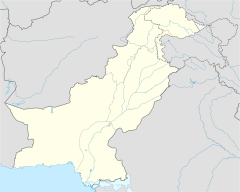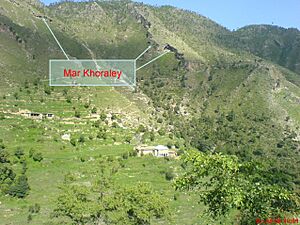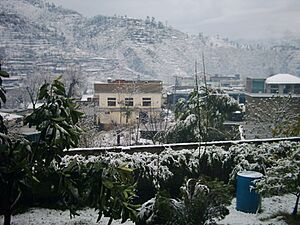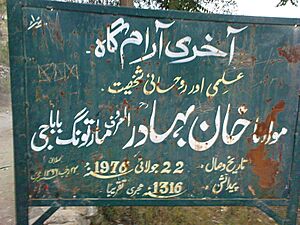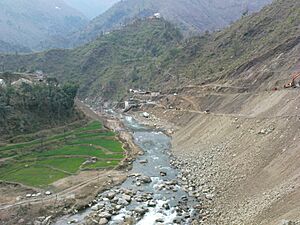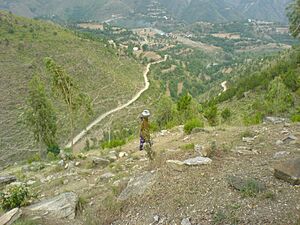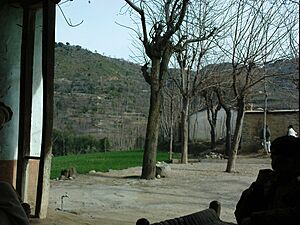Martung facts for kids
Quick facts for kids
Martung Tehsil
تحصیل مارتونگ
مارتونګ تحصیل |
|
|---|---|
|
Tehsil and village
|
|
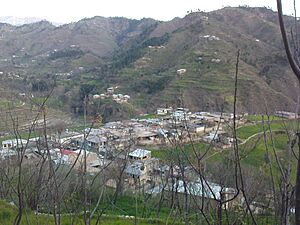 |
|
| Country | |
| Province | Khyber Pakhtunkhwa |
| District | Shangla District |
Martung, also known as Mārtung or Martoong, is a village and a special area (called a tehsil) in the Shangla District of Khyber Pakhtunkhwa, Pakistan. It's part of the Puran Subdivision. The main part of Martung, called Koozkalai, is about 982 meters (3,222 feet) above sea level. Since it's a hilly area, some parts of Martung are even higher, over 1,800 meters (5,900 feet) high! Martung is a beautiful green valley located in the southeast of Shangla District, about 5 kilometers (3 miles) northwest of the River Indus. Some of its important villages include Kabalgram, Pishlor, Titwalan, Koozkalai, Manzkalai, Shaga, and Karindara.
Contents
What's in a Name?
The name "Martung" might come from "Mar Tuang," which means "snake charmer basket." The central part of Martung is a low valley surrounded by high hills, which looks a bit like a snake charmer's basket. There's also an old story about a huge monster snake that used to live in Martung. This snake supposedly ate rocks and soil from a part of the Tangiyal hill. That part of the hill now looks like something has eaten it away, and it's called "Mar Khoraley," which means "eaten by snake" in the Pashtu language. Both these ideas suggest the name "Martung" came from "Mar Tuang," but it's not fully confirmed.
Getting Around Martung
Martung has roads that connect it to Mingora and Buner. These roads are mostly rough jeep tracks, not smooth paved roads. Mingora is the biggest city and a major trading center nearby. However, because the road to Buner is a bit better, and there have been fewer problems with Taliban activities there, people often prefer to go to Buner for shopping and to travel to other parts of the country. There are also two other jeep tracks from Martung to Chakesar and Kabalgram. The Chakesar road connects to the Mingora-Besham road. From Kabalgram, you can cross the Indus River to reach a road that goes to Mansehra and other parts of the Hazara area.
Martung's Weather and Water
Climate
Unlike some other parts of Shangla, Martung usually has mild winters, and the valleys get only a little snowfall. Areas very close to the Indus River can get quite hot in summer.
One big problem for Martung has been deforestation. People in this area don't have access to coal or natural gas for heating or cooking. They also face issues with electricity, like low voltage and frequent power cuts, even though the area is connected to the national power grid. Because of this, people have been burning wood for their homes for a very long time. Even though it's not super cold, temperatures can drop below freezing in winter, so people need to keep their houses warm. In the past, there were thick forests of pine and olive trees in the valleys, but now you can only find forests on the far, high hills.
Water Situation
Martung doesn't have as much water as other parts of Shangla District. Water is only plentiful in Sinkarai, which are the areas very close to the Indus River. These include villages like Kabalgram, Dedal, Kamach, and Behar. The rest of Martung has many springs and small streams, but they usually depend on the yearly rainfall. For a long time, people used spring water for drinking and carried it to their homes. Some small pipes from springs to houses are also common. However, there isn't a proper water supply system for everyone.
Since the early 1990s, changes in the environment have caused Martung to get less rain than before. Some people in the valley now dig wells to get water. In the main village of Martung, you have to dig about 50 meters (164 feet) deep to find water. This situation has also caused the amount of water in springs and small rivers to decrease. For the last 10 to 15 years, only two small rivers, Eitai and Khowar, flow all year, and even they have less water than they used to. This has greatly reduced the amount of rice grown in the area, which is one of their main crops.
People of Martung
- Faisal Zeb
What People Do for Work
Most people in Martung make a living from farming. The soil here is rich and good for growing crops, but there's no irrigation system. Farming mostly depends on rain. People are often not wealthy and use old, traditional farming methods and tools. They mainly grow wheat, maize, and rice, but not enough to sell a lot. These crops are usually just enough for their own families to eat. Since Martung is far from the main market in Mingora, it's too expensive to transport their products to sell. People grow vegetables and fruits only in small amounts for themselves.
Many people from Martung go to big cities like Lahore and Karachi to find jobs. They often work as watchmen, waiters in restaurants, or laborers. A small number of people have small businesses in the local market, and a few work for the government.
Population and Education
The population of Martung Tehsil is over 85,000 people. In 1998, it was about 79,000. The central town of Koozkalai has about 6,500 people. The number of people who can read and write (literacy rate) in Martung is very low. On average, less than 7% of males and less than 1% of females can read and write. This number is a bit higher in larger villages like Kabalgram, Koozkalai, Shaga, Karindara, and Manzkalai.
Until 2006, there was only one high school for boys in the area, along with a few middle and primary schools for both boys and girls. The number of students and the quality of education are both very low in all these schools. Many primary schools are "ghost schools," meaning they have no students or even proper buildings. The only middle school for girls in Koozkalai has a big shortage of teachers. Some female teachers who were appointed through political connections rarely visit the school. Instead, many of them hire less educated, poorer girls to teach in their place for a very small payment. However, a few private schools offer a better learning environment for female students compared to the government schools.
Culture and Beliefs
The people of Martung have a rich culture and strong moral values. Unlike the general idea some people have about Pathans, Martungis are peaceful. Fights between tribes are very rare. Some traditional Pathan customs, like Hujra (a community guesthouse) and Jirga (a traditional council), are still active in most villages.
Most people in Martung belong to the Aziz Khel or Azikhel and Khan Khel sections of the major Pathan tribe, Yousafzai. Pashto is the main language spoken by everyone. A very few families in far-off hilly areas speak Gujri as their first language and Pashto as their second. Since Urdu is the national language of Pakistan, most people understand it.
All the people of Martung are Sunni Muslims. Maulana Khan Bahadur (who lived from about 1898 to 1976), known as Martung Babajee, was a very famous religious and spiritual leader in Martung's history. During his lifetime, religious students from all over Khyber Pakhtunkhwa and Afghanistan would come to Martung to learn from him.
Hakeem Sahib of Alamibanda
Hakeem Sahib of Alamibanda is a well-known person in Martung, famous for his traditional medicines. He didn't go to a formal medical school but learned remedies and recipes from his family. He has become famous across the country for a special recipe he uses to treat cancer. Since he's not officially allowed to practice medicine, some people might question his treatments. However, many cancer patients who are feeling hopeless visit him from all over Pakistan, hoping his medicine will help them feel less pain.
Community Facilities
Martung doesn't have many basic necessities and facilities. Health and education services haven't really improved for about thirty years. Roads haven't gotten better since 1969, when the former Swat State became part of the Government of Pakistan. The only improvements have been some rough jeep tracks built by the people themselves, with very little help from the local government.
However, as people have become more aware and lifestyles have changed, the local market has improved. Most everyday items are now easy to find. Martung got connected to the national electricity grid and telephone network in 2006–07.
Health Services
Martung has a Rural Health Center (RHC) that has been active since 2018. It was upgraded from a Basic Health Care Unit (BHU) and is located in central Martung, Koozkalai. Besides this, there are some private health clinics, but no major medical or surgical facilities. People from Martung usually have to travel about 20 kilometers (12 miles) to Swat, Buner, or Puran to get proper healthcare.
Education Services
Government High School Martung is the oldest school in the area. The Middle School Martung was opened by the Government of the former Swat State in the 1960s. It was upgraded to a high school in 1980 but hasn't changed much since then. This was the only high school in the Tehsil until 2006, when Middle School Titwalan and Middle School Pishlor were also upgraded to high schools. There are also a few middle and primary schools in the tehsil that provide basic education.
However, these schools often lack basic things like chalk and blackboards. Neither the teachers nor the parents seem very interested in these schools. Many primary schools are "ghost schools" with no students or even proper buildings. The only middle school for girls in Koozkalai has a serious shortage of teachers. A few private schools, however, offer a better learning environment for female students compared to the government schools.
Roads
The government of the former Swat State built a simple road (without black topping) from Mingora to Martung, going through Puran. Even though it wasn't paved, this road was well-maintained during the time of the Swat State until 1969 and was considered one of the best tracks back then. After the Swat State joined Pakistan, the road was neglected and didn't improve much until the early 1990s. In the 1990s, Pir Muhammad Khan of Puran, who was a Member of Provincial Assembly for five terms, took an interest in the part of the road from Mingora to Puran and improved it a little. But its condition is still not great.
Another simple track road from Buner has also been built and connects to the existing road between Puran and Martung. This road is likely to be improved in the future. It gives people a second way to connect with the rest of the country, especially in harsh winter conditions when the other road is blocked by snow or very difficult to use.
The Martung-Chakesar link road is also being improved and should provide another way soon. The Martung-Kabalgram road is yet another way to reach Hazara Division from Kabalgram by crossing the Indus River. However, this track is in very poor condition and can only be used by special jeeps. This was the only way for people from Puran and Martung to leave the area when the Buner and Mingora roads were blocked because of the Taliban movement and army operations in 2009. People have also built small connecting tracks from the main road to many small villages themselves, with little or no help from the government.
Telephone and Electricity
Martung was not connected to the national electricity grid or telephone network until 2006. In 2006–07, electricity was supplied to Martung, followed by a telephone exchange. Mobile phone service also became active in 2008. However, all these connections were badly affected by the activities of the Taliban and the army operations against them. The telephone network in the area has still not been fully restored.
Water Supply
Access to clean drinking and household water is a very basic need that Martung still struggles with. Water has been a problem in Martung for a long time. People used to get water from nearby springs for their homes as long as there was enough water available. With more people living there, changes in how people live, and worse water conditions, people are trying to find other ways to get water. There isn't a proper water supply system for the whole area. (You can read more about the water situation earlier in this article.)
The Battle of Shaga
"Da Shage Jang," which means "Battle of Shaga," is an important event in Martung's history. Shaga is one of the main villages in central Martung, about two kilometers from both Koozkalai and Manzkalai. The people of Shaga belong to the Chagharzai sub-tribe of Yousufzai, and historically, they were rivals of the Azikhel, who live in Koozkalai and Manzkalai.
In the early 1900s, Shaga was very strong and had a protective wall around the village. At that time, there was no real government control in this area, and people lived by tribal rules. The Chagharzai tribe was very powerful and seen as a threat by the Azikhel. So, in September 1908, the Azikhel decided to fight a big battle against them. They gathered their forces from nearby areas like Chakesar and Shahpur and attacked Shaga together. Shaga's defenses were very strong, and at first, they shot down the rival leaders from behind their protective wall. In the evening, the Azikhel managed to break through the wall and enter the village. They burned the entire village and killed almost all the men, except for young boys and children who were taken away by their mothers.
For a long time, people in Martung used "Da Shage Jang" as a way to remember dates and count years. Some older people in Martung still remember this event. Since this event isn't written down anywhere, some of the exact details and stories connected to it are not fully confirmed.
Earthquake in 2005
Martung was hit by a strong earthquake on October 8, 2005. This earthquake caused many deaths and left hundreds of people without homes.
Notable People
- Maulana Safiullah Dadaji (1870-1948) - a respected religious scholar and Islamic thinker.
Images for kids


